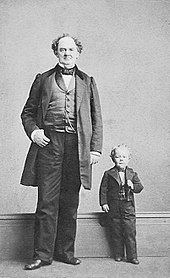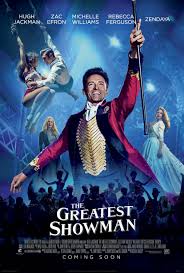Opinion: The Truth About The Greatest Showman

Barnum towering over one of his most famous performers, General Tom Thumb
January 31, 2018
The Greatest Showman hit theaters December 8th, stunning audiences with its magic and music. The new movie musical dapples into a little bit of every topic from touching on racism to greed to family. What most don’t know is how the film was inspired and revolved around the life of P. T. Barnum – the man himself was criticized as a racist, a slave buyer and an exploiter. So, what is real and what is not in the new box office hit, The Greatest Showman? Warning: Spoilers ahead!
To directly acknowledge your fears from the get go… no, P.T Barnum did not cheat on his wife, Charity Hallet with the Swedish opera singer, Jenny Lind. There was no recorded relationship between Barnum and Lind. The movie portrays Jenny Lind’s character as lovestruck for Barnum, although in real life, that was not the case at all. In reality, Lind accepted Barnum’s proposal for the American tour because she was promised a massive sum of money. Admirably, Lind did not keep the money for herself and never planned on it – instead she donated her earnings to charities, more specifically to Swedish free schools. Lind donated $350,000, which in today’s world is equivalent to $10 million. Lind cut the tour early due to her uneasiness about Barnum’s relentless marketing of her talent, not because of affair motives.
Barnum’s controversial past started when he bought an elderly slave, Joice Heth, who he advertised as a 161-year-old woman who served George Washington as his nurse. Heth was blind and nearly paralyzed and worked for Barnum’s show business until her death. Her true age was revealed to be around 80 years old after an autopsy was performed.
In one particular scene, P.T. Barnum and his colleague Philip Carlyle, Zac Efron’s character, discuss business over shots of alcohol. Two major false details about scene are 1) Philip Carlyle was not a real person in P.T Barnum’s life, he is fictitious and 2) the true Barnum was a temperance speaker – he toured the U.S. speaking about the dangers and corruptness of alcohol.
Lettie “The Bearded Lady” Lutz was a real contribution to the P.T. Barnum Circus. In the movie, she was named Lettie Lutz, but the true wonder was actually named Annie Jones. Jones was exhibited by Barnum as young as 9 months old and was known as “The Infant Esau” (Esau is the Hebrew word for “hairy”). Her parents were paid a $150 weekly salary.
Is Zendaya’s character, Anne Wheeler, based on a real woman, too? No. Wheeler is a fictional character, probably created to introduce the racial issues in the time period and to be Zac Efron’s character’s love interest. (I’m not mad about this inaccurate detail.)
The Greatest Showman writers did their research when they incorporated Charles Sherwood Stratton, or General Tom Thumb, into the movie but what they tweaked was his age. The miniature man in the movie was not a man at all, in reality. Barnum recruited a 4-year-old, who happened to be a distant cousin of his. Stratton was born a healthy baby, but unexpectedly stopped growing around 6 months, achieving a height of 25 inches in his lifetime.
In the movie, the Barnum family’s two daughters were prominent characters. In reality, Phineas Taylor Barnum (P.T. Barnum) and Charity Hallet had four children. Three reached adulthood, while one of their daughters passed from an unexpected death.
A major, genuine event that occurred in both Barnum’s life and in The Greatest Showman was the burning of the Barnum American Museum on July 13, 1865. The cause of the fire is unknown, though there are speculations it was done by a Confederate arsonist due to the fact that Barnum hosted pro-Unionist events at the Barnum American Museum. Barnum recovered from the setback and rapidly changed locations for the museum, although that too suffered from a fire in 1968. His start in the circus business initiated from there.
“The noblest art is that of making others happy,” said P.T. Barnum. Although The Greatest Showman was not entirely factual, it did bring joy to audiences’ hearts and tears to their eyes. P.T. Barnum sold deceiving performances but the fact of the matter is… it made people happy. It is not a crime in my books that the truth was tweaked a bit, as long as it made others happy.
References:
“P. T. Barnum.” Wikipedia, Wikimedia Foundation, 27 Jan. 2018, en.wikipedia.org/wiki/P._T._Barnum.
“The Greatest Showman (2017).” History vs Hollywood, HistoryvsHollywood, 2017, www.historyvshollywood.com/reelfaces/greatest-showman/.
Schwartz, Dana. “11 Questions We Had about ‘The Greatest Showman’.” EW.com, Entertainment Weekly, 21 Dec. 2017, ew.com/movies/2017/12/21/greatest-showman-burning-questions/.
Redmond, Caroline. “The True Story Behind Hugh Jackman’s The Greatest Showman.”PEOPLE.com, People, 5 Jan. 2018, people.com/movies/the-true-story-behind-hugh-jackmans-the-greatest-showman/.



